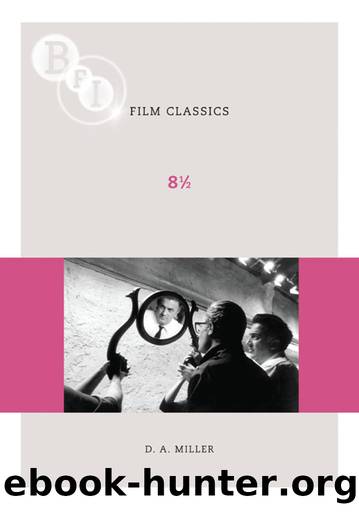Eight and a Half (Otto e Mezzo) by Miller D. A.;

Author:Miller, D. A.;
Language: eng
Format: epub
Publisher: BFI Publishing
Published: 2019-11-15T00:00:00+00:00
What is eliminated with the train ending, then, is the only thing it doesnât share with the other â namely, the train itself â and the screenplayâs overheated last sentence helps us understand why. We know this train. It is the train of nineteenth-century novels, where it is driven by Jacques Lantier over the body of Anna Karenina; the train of golden-age detective stories, where its passengers regularly go missing, or are found dead; the train of early cinema, where it threatens to run down Lumièreâs spectators; the train of Hollywood genre films, where, if the Western doesnât rob it, the war film blow it up or the horror film fill it with phantoms, the thriller earmarks it for equally unlucky encounters between strangers.24 Last but not least, it is the train of Felliniâs own autobiographical I vitelloni (1953), where, as Tatti Sanguinetti has noted, it takes the hero on a journey from which he will never be allowed to return. Yes, we know this train; from the beginning of locomotion, representation has hardly given us another. Freighted with fatality, it clickety-clacks to the very rhythm â âpowerful, unstoppableâ â of the death drive.
By all accounts, Felliniâs train was eminently worthy of this tradition. Everyone reports being spooked by it. To Tullio Pinelli, one of the screenwriters, it was âfunerealâ, ghostly; to Anouk Aimée, it was âmysteriousâ (âWhere were we going? Were we dead?â); and to Lina Wertmüller, then Felliniâs assistant director, it frankly âstank of deathâ. In the Ronald photograph, it is striking how pointedly the pattern of light and dark reverses that of the opening traffic jam, as if in conclusive response.25 Then, despite the gloomy congestion in the foreground, there was light at the end of the tunnel; now, it is the foreground that is bright, while the perspective disappears into darkness.
Wertmüller claims that, in rejecting the train ending, Fellini laudably chose the fragrance of life over the stench of death. But he also, more problematically, preferred an extrinsic ending to an intrinsic one. As weâve had ample occasion to observe, GAâs digressive flights of fantasy all end by landing him back in his starting position with renewed heaviness. If anything, his crisis gets worse over the course of the film, repeating itself in spirals of increasing intensity. This repetition is what the train ending threatens to continue, presumably until GA is totally undone, and his epiphany with him. If there is a problem with this train ending, it is that it suits 8½ all too well. It figures the perpetuation of what has been the filmâs death-driven logic all along.
It is not surprising that Fellini should finally want to reject this unstoppable locomotive dissipation in favour of the circus ringâs holistic binding, even though, as weâve seen, the ring is soon overshadowed by melancholy. After all, melancholy might be a psychic price worth paying in order to preserve â as a âlossâ one never gets over â what one would otherwise have lost for good: people, the past, self-ideations.
Download
This site does not store any files on its server. We only index and link to content provided by other sites. Please contact the content providers to delete copyright contents if any and email us, we'll remove relevant links or contents immediately.
The Switch by Beth O'Leary(1291)
Sisters by Daisy Johnson(1262)
The Enemy by Sarah Adams(1220)
Guard Duty by Sharon Dunn(997)
The Christmas Killer by Alex Pine(939)
The Chronicles of Narnia -Complete Series- by C. S. Lewis(892)
Explosive Situation by Terri Reed(873)
Alaskan Showdown by Sarah Varland(843)
The Ruthless Billionaire by Evangeline Kelly(801)
Dangerous Women by Hope Adams(780)
Fans Only by B. Love(754)
The Heart's Song by Winnie Griggs(720)
Valley of Shadows by Shirlee McCoy(706)
TRUTH by James Crow(691)
Truth of the Divine by Lindsay Ellis(690)
Nine by Rachelle Dekker(661)
World's End by Ed James(648)
Forget Me Not by Sarah M. Eden(587)
Kill Order by Adam Blumer(586)
